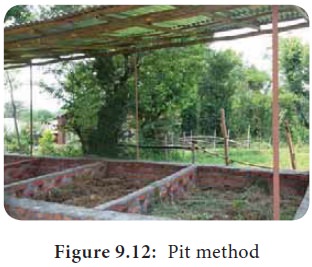Compost bed types, Methods of compost preparation, Benefits of compost - Composting | 11th Microbiology : Chapter 9 : Environmental Microbiology
Chapter: 11th Microbiology : Chapter 9 : Environmental Microbiology
Composting
Composting
Compost is organic matter that has been decomposed and recycled
as a fertilizer and soil amendment. It is a mass of rotted organic matter made
from waste. Example: garbage, paper, sugarcane trash, paddy straw, aquatic
weeds, other agricultural waste.
Composting is a natural process in which aerobic and anaerobic
microorganisms decomposes organic matter into valuable manure called as
compost. The primary objective of composting is to convert an unstable material
into stable end product (Figure 9.11).

The humification of organic material occurs in three stages
1. Mesophilic stage - Mesophilic is the initial stage of decomposition, lasting for about a week, during
which sugars and other simple carbohydrates are rapidly metabolized. This is an
exothermic process and may cause an increase in temperature by 40°C. Example: Bacillus subtilis
2. Thermophilic stage - Thermophilic is the second stage, lasting for about two weeks, during which the
temperature may rise to about 50 to 75°C. Such a drastic increase in temperature
is accompanied by the decomposition of cellulose and other resistant materials.
It is important that the material be thoroughly mixed and kept aerated during
this stage. Example: Bacillus
stearothermophilus
3. Curing stage - The temperature decreases during this final stage and the material being
composted is recolonized by mesophillic organisms, which often produce
plant-growth stimulating compounds.
The humification of organic material is characterized by an increase in concentration of humic acids approximately from 4 to 12 percent, and decreases during the composting process.
Compost bed types
1. Pit method
2. Heap method
Pit method
The compost pits dug in soil with dimension of 3.5m x 2.5m x 1.5m

The pits are filled layer by layer using
green plants and animal excreta. The layering is repeated until the pit is
filled. Finally a layer of mud is plastered on the top of the pit (Figure
9.12).
Heap method
In regions with heavy rainfall, the compost may be prepared in heaps above the ground level and protected by a shed. The pile is made with dimension of 2m x 2m x 1.5m (LxBxH) (Figure 9.13).

Methods of compost preparation
1. Indore method
2. Bangalore method
Indore method
This method was developed at Indore, India. In this method
organic wastes are spread in the cattle shed to serve as bedding. Trenches are
dug with dimension of 10ft x 6ft x
2ft.
Dry wastes with cattle dung and soil are added in ratio of 4: 2:
1 up to 2 inches layer in composting pit. A moisture level of about 40-50% is
ideal for good composting. Odour and insect problems can be controlled by
covering the piles with a layer of soil or wood chips.
The heap is left undisturbed for about 8 to 9 months. Turning
the pile for every 15 days is important for coplete composting because pile
needs a periodic influx of O2. Plant residues, weeds, sugarcane
leaves, grass, wood ashes, animal dung, and water urine soaked mud can also be
used as raw materials for this type of composting.

Bangalore method
·
This method was developed at Bangalore, India. It is recommended
as a satisfactory method for disposal of town wastes and night soil.
·
The compost pits dug in soil with dimension of 4.5m x 2.5m x 90cm (LuBuH)
·
In the Bangalore method of composting, dry waste material of
25cm thick is spread in a pit and a thick suspension of cow dung in water is
sprinkled over for moistening.
·
A thin layer of dry waste is laid over the moistened layer
·
The pit is filled alternatively with dry layer of material and
cow dung suspension till it rises 0.5m above the ground level and plastered
with wet mud and left undisturbed for about 4-6 months or till required.
·
This method saves labour cost because there is no need of
turning & regular sprinkling of water.
Benefits of compost
·
Compost improves the quality of soil hence called as a soil
conditioner.
·
Compost contains a variety of the basic nutrients required for
healthy growth of the plant.
·
Nitrogen, phosphorous, potassium and certain micronutrients viz, manganese, copper, iron and zinc
are found in compost.
·
The composted product is safe and easy to handle, and does not
induce nitrogen deficiency in recipient plants by nitrogen stabilization in the
compost.
·
It suppresses disease
infestation by partial
sterilization and detoxifies pollutants.
·
Compost material is principally used for the reclamation of
drastically disturbed. Example: mined soil, landscaping and agriculture.
·
Compost finds unrestricted application in parks and gardens for
ornamental plants, in land reclamation and highway beautification projects.
Related Topics